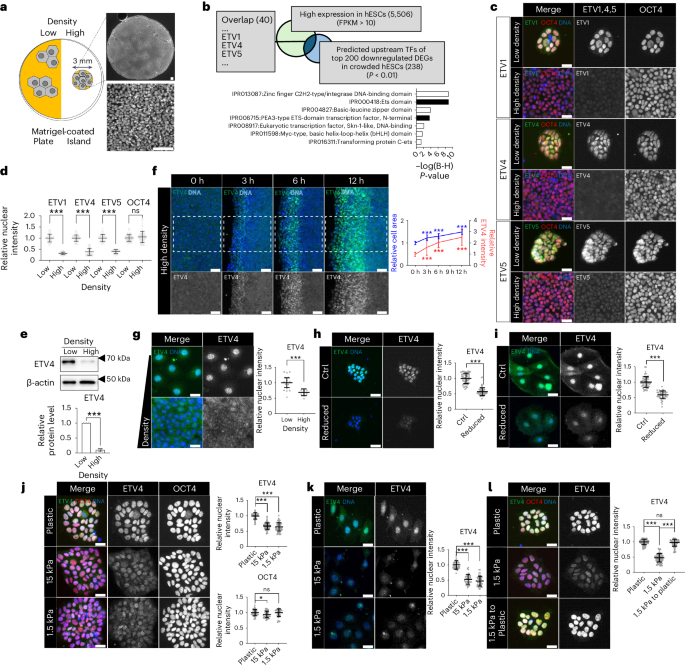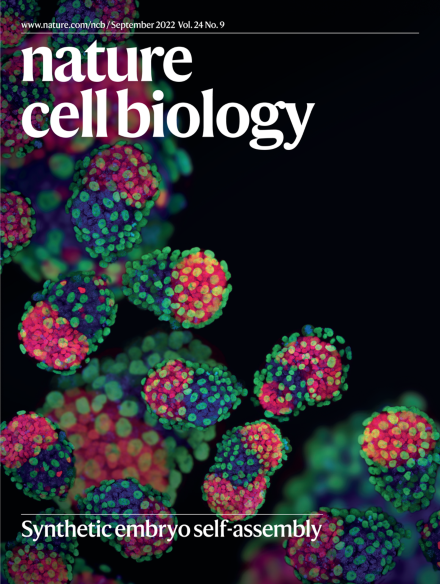ETV4是一种将细胞拥挤动力学与血统规格化联系起来的机械换能器
IF 17.3
1区 生物学
Q1 CELL BIOLOGY
引用次数: 0
摘要
机械微环境的动态变化(如细胞拥挤)会调节细胞系的命运以及细胞的增殖。虽然接触抑制增殖的调控机制已被广泛研究,但细胞拥挤如何诱导系谱分化仍不清楚。在这里,我们发现一种著名的癌基因--ETS变异转录因子4(ETV4)是连接机械微环境和基因表达的分子换能器。在人类胚胎干细胞的上皮细胞生长过程中,细胞拥挤动态转化为ETV4的表达,成为未来细胞系命运的前模式。在人类胚胎干细胞上皮细胞中,类似开关的ETV4因细胞拥挤而失活,从而抑制了神经外胚层分化的潜力。从机理上讲,细胞拥挤会使整合素-肌动蛋白通路失活,并阻断成纤维细胞生长因子受体(FGFR)的内吞。成纤维细胞生长因子受体内吞功能的中断会导致ERK失活,从而使ETV4蛋白的稳定性显著下降。数学建模表明,生长中的人类胚胎干细胞上皮细胞的细胞密度动态精确地决定了ETV4的时空表达模式,进而决定了细胞系发育的时间和几何形状。我们的研究结果表明,干细胞上皮细胞中的细胞拥挤动力学利用ETV4作为关键的机械换能器,驱动时空上的细胞系分化。本文章由计算机程序翻译,如有差异,请以英文原文为准。


ETV4 is a mechanical transducer linking cell crowding dynamics to lineage specification
Dynamic changes in mechanical microenvironments, such as cell crowding, regulate lineage fates as well as cell proliferation. Although regulatory mechanisms for contact inhibition of proliferation have been extensively studied, it remains unclear how cell crowding induces lineage specification. Here we found that a well-known oncogene, ETS variant transcription factor 4 (ETV4), serves as a molecular transducer that links mechanical microenvironments and gene expression. In a growing epithelium of human embryonic stem cells, cell crowding dynamics is translated into ETV4 expression, serving as a pre-pattern for future lineage fates. A switch-like ETV4 inactivation by cell crowding derepresses the potential for neuroectoderm differentiation in human embryonic stem cell epithelia. Mechanistically, cell crowding inactivates the integrin–actomyosin pathway and blocks the endocytosis of fibroblast growth factor receptors (FGFRs). The disrupted FGFR endocytosis induces a marked decrease in ETV4 protein stability through ERK inactivation. Mathematical modelling demonstrates that the dynamics of cell density in a growing human embryonic stem cell epithelium precisely determines the spatiotemporal ETV4 expression pattern and, consequently, the timing and geometry of lineage development. Our findings suggest that cell crowding dynamics in a stem cell epithelium drives spatiotemporal lineage specification using ETV4 as a key mechanical transducer. Yang, Golkaram et al. reported that in human embryonic stem cells, cellular crowding leads to the blockade of FGFR1 endocytosis, resulting in a decrease in ETV4 expression. This, in turn, derepresses the neuroectoderm fate.
求助全文
通过发布文献求助,成功后即可免费获取论文全文。
去求助
来源期刊

Nature Cell Biology
生物-细胞生物学
CiteScore
28.40
自引率
0.90%
发文量
219
审稿时长
3 months
期刊介绍:
Nature Cell Biology, a prestigious journal, upholds a commitment to publishing papers of the highest quality across all areas of cell biology, with a particular focus on elucidating mechanisms underlying fundamental cell biological processes. The journal's broad scope encompasses various areas of interest, including but not limited to:
-Autophagy
-Cancer biology
-Cell adhesion and migration
-Cell cycle and growth
-Cell death
-Chromatin and epigenetics
-Cytoskeletal dynamics
-Developmental biology
-DNA replication and repair
-Mechanisms of human disease
-Mechanobiology
-Membrane traffic and dynamics
-Metabolism
-Nuclear organization and dynamics
-Organelle biology
-Proteolysis and quality control
-RNA biology
-Signal transduction
-Stem cell biology
 求助内容:
求助内容: 应助结果提醒方式:
应助结果提醒方式:


